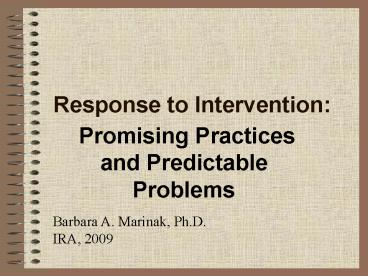Response to Intervention: - PowerPoint PPT Presentation
1 / 26
Title:
Response to Intervention:
Description:
assigned to an interventionist during a given. period. Tier Two should be ... Primum non nocere (First, do no harm) The two ways 'harm' appears possible has ... – PowerPoint PPT presentation
Number of Views:47
Avg rating:3.0/5.0
Title: Response to Intervention:
1
Response to Intervention
- Promising Practices and Predictable Problems
Barbara A. Marinak, Ph.D. IRA, 2009
2
- IDEIA (Individuals with Disabilities Education
Improvement Act 2004) mandates the use of early
intervening services for - Identifying children who are members of a
disaggregated subgroup with a specific learning
disability whereby the discrepancy model could
result in over identification.
3
- Provide intervention to all children at risk for
school failure.
4
- For most models, Tier One is core classroom
- instruction. Tiers Two and Three are varying
- levels of intervention.
- Today, we will consider promising practices
- and predictable problems for Tiers 1-3.
5
Promising Practices in Tier 1- Core
6
- More discussion about core reading practices
- Recognition of need for balanced instruction at
all grade levels - Recognition of need for balanced collections at
all grade levels
7
- Core classroom data is at the table
- More staff development for classroom teachers
8
Predictable Problems in Core
9
Planning Questions
- What are the strengths and needs of your current
reading program? - instructional practices
- time allocations
- group size
- group membership
- We have seen too many meetings where a
- focus on data diminishes classroom efforts.
10
- Does every child receive reading instruction
every day in a small-differentiated group
delivered by the classroom teacher? - Is there consistency within a classroom and at a
grade level in how language arts minutes are
allocated across the subjects? - Has the classroom teacher been trained in a
research-based collection of instructional
methods?
11
Tier 2A Differentiated Double Dose
- Tier Two intervention should be delivered in
addition to, never in lieu of, core classroom
instruction.
12
Promising Practices in Tier 2
- School-wide screening is being implemented
- Intervention is being provided based on data
- Intervention teams represent the disciplines that
can effectively inform intervention
13
Predictable Problems in Tier 2
14
1 Highly Qualified Interventionists
- How many reading specialists are available to
deliver intervention? - How does the master schedule need to be revised
to ensure that the reading specialist can provide
seamless services to each targeted grade level? - Is the reading specialist well versed in the
instructional priorities of the core classroom
program?
15
2 Intensity/Ratio
- Intensity is the length and duration of the
- intervention. Ratio is the number of students
- assigned to an interventionist during a given
- period. Tier Two should be delivered in
- addition to, never in lieu of, core reading
- instruction. The essential questions include
16
- How much time is available in the school day to
double dose struggling readers? - How long is each intervention period (20 minutes,
30 minutes, 45 minutes, etc.)? - Is there a plan to avoid the roller coaster
effect (i.e. students moving in and out of
intervention haphazardly based on limited data)? - Is the reading specialiststudent ratio reduced
during the intervention compared to the core
reading instruction?
17
3 Method
- Method is the instructional approach
- chosen for the intervention group.
- As we plan intervention groups, the
- following questions prove helpful
18
- What does the classroom and/or diagnostic data
reveal about student needs? - What method(s) are indicated within a grade level
intervention population? - Does the method selection consider all available
data? In other words, is the intervention
balanced?
19
Promising Practices in Tier 3
- Better differential diagnosis
- Dramatic increases in intensity more one to one
intervention
20
Predictable Problems in Tier 3
21
Primum non nocere (First, do no harm)
- The two ways harm appears possible has
- been described by our teacher colleagues as
- (a) piling on with no plan, and/or
- (b) commitment needed
22
1.Commitment
- As Joanna Yatvin (2007) so eloquently suggested,
be a catcher in the rye. Plan Tier Three
intervention based on the very individual
differences that are present in our most
struggling students. Consider all the data,
choose a comprehensive method (not methods) that
is congruent with core classroom instruction, and
make a commitment to the child (and the method)
for months-- not days or weeks.
23
2. Professional Decision-Making
- Avoid the analogy that students are billiard
balls on a pool table. Predictable trajectories
are rarely seen in struggling readers, therefore,
prescriptions will invariably fail. The missing
ingredient in a describe-prescribe focus is
professional decision-making.
24
3. Teach Transference
- Plan to teach transference. The most successful
interventions fail because struggling readers
have difficulty transferring newly acquired
strategies from text to text, classroom to
classroom, and year to year. Tier Three teams
need to discuss how transference will be taught
-- with all instructional stakeholders speaking
the same literacy language.
25
Conclusion
- At this point, RTI appears to be a Problem
- Solving Model for instructional intervention
- and/or a Protocol Approach for the
- identification of SLD.
- However, at present, there is insufficient
- research evidence for many important
- considerations.
26
- It is not known how to establish cut-points for
identification and levels of intervention beyond
early reading. - The consequences of wide implementation of RtI
for LD identification are not known. - Most importantly, the response of general
education to RTI is not known. In fact, whether
general education is even aware of the RtI debate
is unknown. USDOE, 2007































